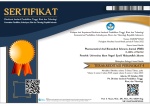Analytical Methods Validation of Retinoic Acid and Hydroquinone Using Ultra High Performance Liquid Chromatography in Medicinal Cream
Abstract
Hydroquinone and retinoic acid have been widely used as whitening agents in cosmetic creams and have a negative impact if used without a medical prescription. In this study, development of analytical method of retinoic acid (REA) and hydroquinone (HYQ) were carried out using Ultra High Performance Liquid Chromatography (UHPLC) with a PDA detector, Phenomenex Luna® ODS / C18 column (150 mmx4.6 mm), methanol-acetic acid 0.1% (85:15) as mobile phase, flow rate of 1.0 mL/min and detected at 295 nm for HYQ and 341 nm for REA. The result of the validation method showed a retention time of HYQ at 1.55 minutes and REA at 3.73 minutes. Validation parameters performed are selectivity, range, linearity, LOD, LOQ, accuracy, and precision. Linear detector response in the concentration range of 75-250 ppm with a calibration curve equation. The calibration curve equation for HYQ is y = 0.4607x + 1.9014 (r = 0.999), mean while REA is y = 2.3138x + 21.0429 (r = 0.999). LOD and LOQ values of HYQ are 1.615 ppm; 13.98 ppm respectively and REA 1.02 ppm and 3.11 ppm, respectively. The precision (% RSD) ≤ ± 2% and accuracy (% recovery) in the range of 99.0% - 100.6%. This method is valid to be used to analyze HYQ and REA in commercial cosmetic cream samples.
References
Badan Pengawasan Obat dan Makanan (2008) ‘Bahan Berbahaya Dalam Kosmetik’, available at https://www.pom.go.id/new/bahanberbahayadalamkosmetik.
Badan Pengawasan Obat dan Makanan (2011) Peraturan kepala badan pengawasan obat dan makanan Republik Indonesia NO HK.23.08.11, tentang Kosmetik. Internet. Available at https://www.scribd.com/doc/206892134/BPOM
Pengawasan Obat dan Makanan (2003) KeputusanKeplaBadan POM RI No HK.00.05.4.1745, tentang Kosmetik. Internet. Available at https://www.hukumonline.com/pusatdata/detail/lt4f66f999957f2/node/lt50ed35f7e2244/keputusan-kepala-bpom-no-hk.00.05.4.1745-tahun-2003-kosmetik
Kligman, L. H., Duo, C. H. and Kligman, A. M. (1984) ‘Topical Retinoic Acid Enhances the Repair of Ultraviolet Damaged Dermal Connective Tissue’, Connective Tissue Research, 12(2), pp. 139–150.
Harmita(2004)Petunjuk Pelaksanaan Validasi Metode dan Cara Perhitungannya, Majalah Ilmu Kefarmasian, 1(3), pp. 117-135
Martono, S., Febriani, I. and Rohman, A. (2018) ‘Application of liquid chromatography-photodiode array detector for analysis of whitening agents in cream cosmetics’, Journal of Applied Pharmaceutical Science, 8(5), pp. 143–147.
Rahmayuni, E., Harmita, H. and Suryadi, H. (2018) ‘Development and validation method for simultaneous analysis of retinoic acid, hydroquinone and corticosteroid in cream formula by high-performance liquid chromatography’, Journal of Applied Pharmaceutical Science, 8(9), pp. 87–92.
Supandi et al. (2018) ‘Simultaneous analysis of 6-mercaptopurine, 6-methylmercaptopurine, and 6-thioguanosine-5’-monophosphate in dried blood spot using ultra performance liquid chromatography tandem mass spectrometry’, Indonesian Journal of Chemistry, 18(3), pp. 544–551.
The United States Pharmacopeia. (2016) USP 40/The National Formulary, NF 25. Rockville, MD: U.S. Pharmacopeial Convention, Inc., p.2635
Yang, C. H. et al. (2010) ‘Determination of the Thermodegradation of deoxyArbutin in Aqueous Solution by High Performance Liquid Chromatography.’, International journal of molecular sciences, 11(10), pp. 3977–3987.
DOI: 10.15408/pbsj.v1i1.12689
Refbacks
- There are currently no refbacks.






